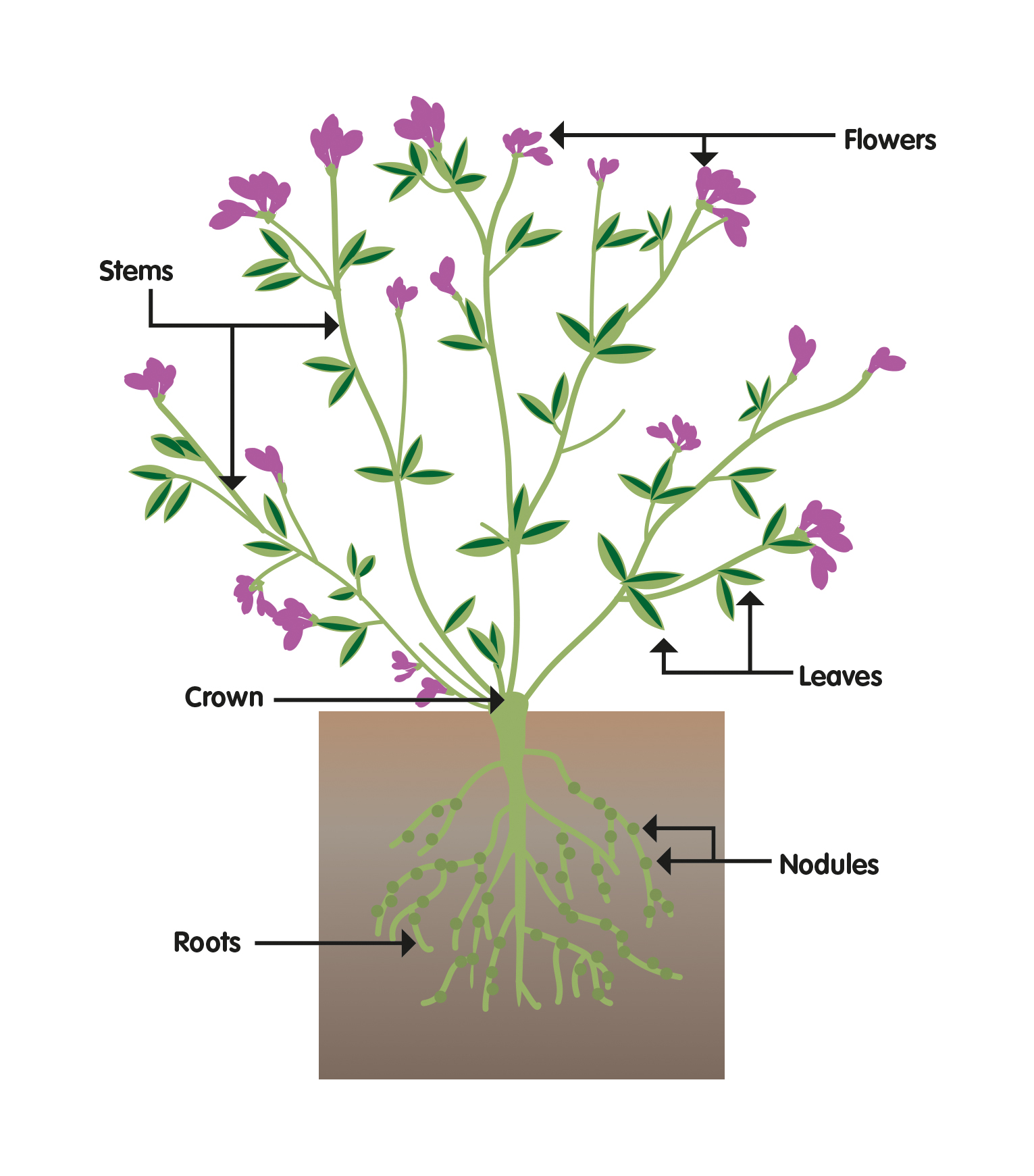- Home
- Knowledge library
- Options for growing lucerne
Options for growing lucerne

Options for growing lucerne
Depending on the required purpose of the crop, you can grow lucerne either on its own or in a mixture.
Understanding how lucerne grows
Lucerne grows off a taproot, which stores nutrients to help the plant regrow after it has been cut or grazed. Like other legumes, such as clover, peas and beans, there are nodules on its roots, which contain nitrogen-fixing bacteria so the crop doesn't need additional applied nitrogen (N) to grow. There have been some reports of lucerne roots going down as far as 15 m in search of water. There could be some risk to drains when growing this crop.

Lucerne is slow to establish. This is partly because it channels energy into root development first, before leaf and stem production.
The plant generally grows well for 4‒5 years, but can last longer. Its persistency is affected by:
- Damage to its crown and taproot
- Soil compaction from machinery
- Any pest and disease challenges
Lucerne exhibits auto-toxicity, which means its seeds will not grow in a field of established lucerne, so it is impossible to ‘top-up’ thinning crops. This also means you need to leave a gap of 5‒6 years between crops.
The nutritive value of lucerne is around 18‒22% crude protein (CP) and around 10 MJ/kg DM of metabolisable energy (ME). You can grow lucerne with certain grasses to improve the feed’s energy content, or feed with maize silage to make a balanced ration for energy and protein. However, even when grown with fescue or timothy as a partner in a sward, competition from the grass can severely reduce the output and survival of lucerne.
Target fresh weight production per year: 40 t/ha (16 t/acre).
Target annual DM yield (at 30% DM for silage) : 12 t DM/ha (4.8 t DM/acre).
Growing options - pure stand (monoculture - on its own)
To maximise protein production per hectare, particularly for crops that will be ensiled, pure stands of lucerne are most effective and the resulting forage complements maize silage well.
Lucerne is slow to get going. So, growing it on its own can be the best way to achieve successful establishment because it is not in competition with other, potentially more aggressive species. However, its auto-toxic nature will prevent over sowing of grasses or other species in the fourth and fifth years of the crop, when production begins to diminish.
Growing options - mixtures
Growing lucerne in a mixture can offer several advantages including:
- Easier harvesting and preservation
- Reduced weed burden
- Reduced bloat risk in grazed lucerne pastures
Depending on the companion species, mixtures will also help to spread production throughout the year, which may be beneficial when growing seasons are short.
You can grow cocksfoot, timothy and tall fescue successfully in mixtures with lucerne. Their drought-tolerant characteristics will enhance production during times of water stress.
Avoid sowing lucerne with quick-growing species, such as Italian or hybrid ryegrasses, as these will outcompete the lucerne seedlings.
Species that are highly active during the winter and dormant during summer are good complements to lucerne. They allow the lucerne crop to flourish in summer and provide good winter cover to prevent soil erosion. They also help increase the yield of the last cut in the season. However, you should consider the risk of lucerne being outcompeted.
Predominantly winter-active legumes, such as subterranean clover or medic, complement the spring, summer and autumn growth of lucerne and are particularly successful in grazing situations. These are rarely grown in the UK.
Growing options - nurse crop
The purpose of the nurse crop is to assist establishment of the lucerne. You can sow lucerne under spring cereals, with priority given to lucerne. Harvest the whole crop silage when the cereal crop is at the milky stage.
Weed burden is a considerable problem at establishment. In some cases, weeds make up as much as 70% of first-cut yield.
The nurse crop will compete with lucerne seedlings for light and nutrients and can hinder establishment. If using a cereal as a nurse crop, using 50–75% of normal seed rate is advisable to help lucerne establish by reducing competition – a maximum of 100 kg/ha of cereal seed.
Considerations for using a cereal nurse crop:
- Where possible, choose a short-strawed, erect variety to avoid smothering the lucerne plant
- If the straw is not baled/picked up as wholecrop, heavy straw may smother the lucerne. It is advisable to scatter the straw evenly. Delayed harvest may mean the lucerne plant hinders harvesting of shorter-strawed varieties
- Crops that tiller well, such as oats, are poor companion crops for lucerne because of their shadowing effect on the under sown lucerne
In other countries, farmer’s successfully grow lucerne with lupins or brassicas.
Latest research - nurse cropping
Research has shown that, at some sites, the use of a nurse crop appeared to reduce the amount of weeds at first cut by almost 40%. Our Dairy Grassland, Forage and Soils Research Partnership investigated the effect of sowing lucerne with a nurse crop of spring barley at three sites in Shropshire, Berkshire and Dumfries.
Weed burden at first cut at one of the sites
In a trial, a nurse crop of spring barley, sown at half rate, was grown to find out whether this could help reduce the weed burden and if this would have any effect on the long-term crop of lucerne. Early results suggest that sowing with a nurse crop can reduce weed infestation in the establishment phase. However, the competitive nature of the barley can result in the survival of fewer lucerne plants.
The research trials demonstrated no consistent advantage or disadvantage in terms of yield or quality in the season of establishment when planting lucerne with a nurse crop of spring barley.
Topics:
Sectors:
Tags:


